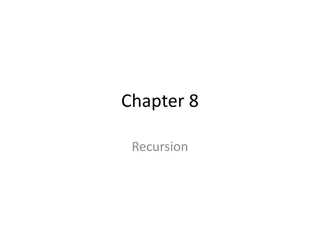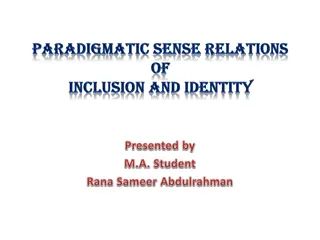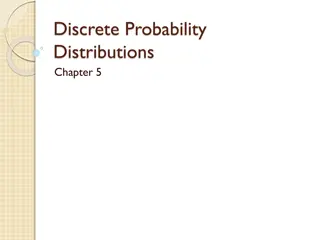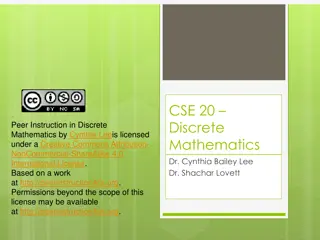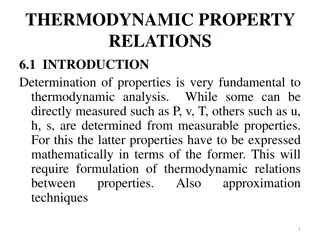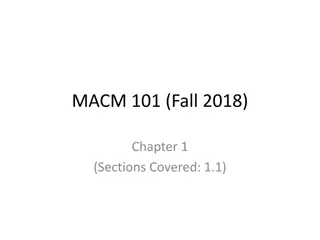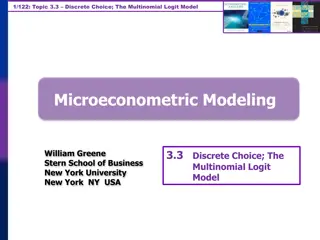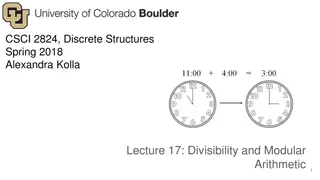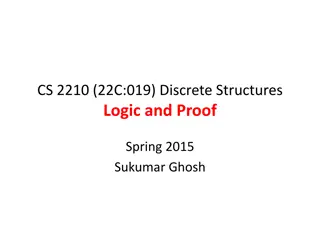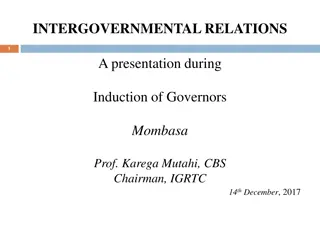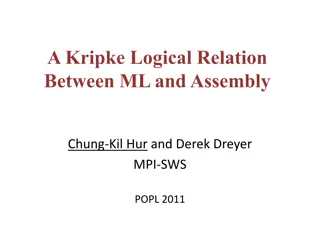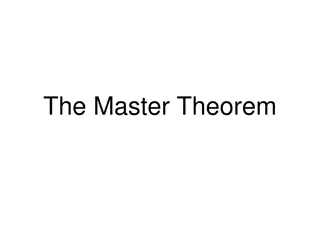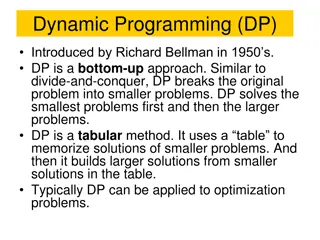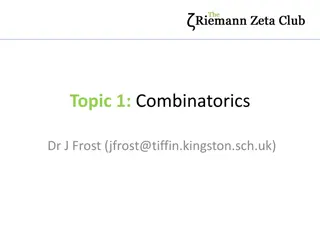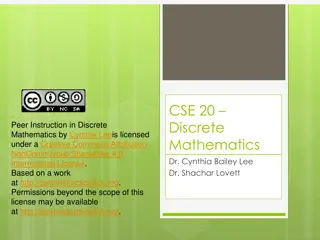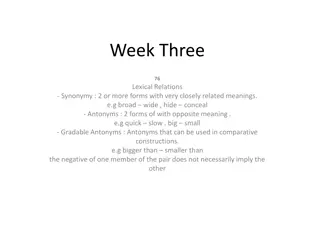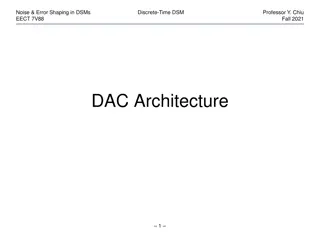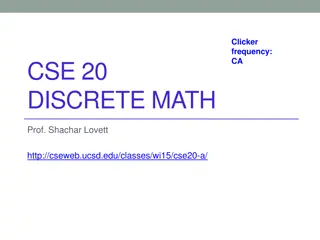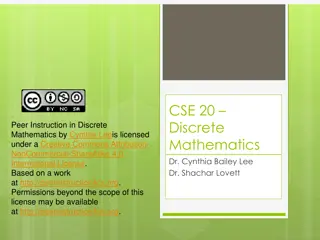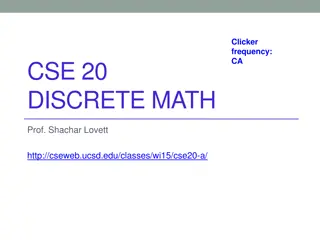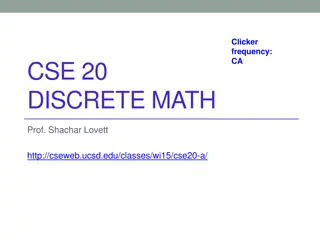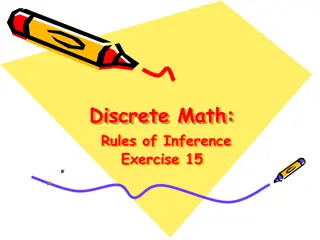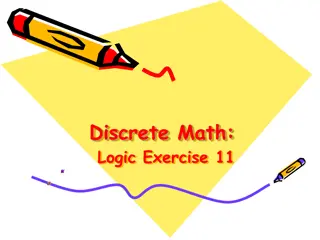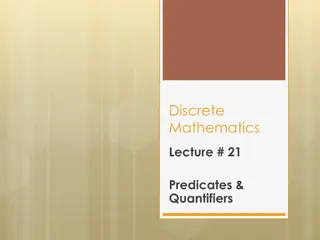Understanding Recurrence Relations in Discrete Structures
Delve into the world of recurrence relations to solve complex mathematical sequences and patterns in discrete structures. Explore scenarios involving compound interest, Fibonacci sequences, bit strings, and the classic Tower of Hanoi puzzle. Discover the power of recursive definitions and their implications in solving iterative problems.
Download Presentation

Please find below an Image/Link to download the presentation.
The content on the website is provided AS IS for your information and personal use only. It may not be sold, licensed, or shared on other websites without obtaining consent from the author. Download presentation by click this link. If you encounter any issues during the download, it is possible that the publisher has removed the file from their server.
E N D
Presentation Transcript
CS 2210 Discrete Structures Advanced Counting Fall 2018 Sukumar Ghosh
Compound Interest A person deposits $10,000 in a savings account that yields 10% interest annually. How much will be there in the account after 30 years? Let Pn = account balance after n years. Then Pn = Pn-1 + 0.10 Pn-1 = 1.1Pn-1 Note that the definition is recursive. What is the solution Pn? Pn = Pn-1 + 0.10 Pn-1 = 1.1Pn-1 is a recurrence relation By solving this, we get the non-recursive version of it.
Recurrence Relation Recursively defined sequences are also known as recurrence relations. The actual sequence is a solution of the recurrence relations. Consider the recurrence relation: an+1 = 2an(n > 0) [Given a1=1] The solution is: an = 2n-1 (The sequence is 1, 2, 4, 8, ) So, a30 = 229 Given any recurrence relation, can we solve it? Which are the ones that can be solved easily?
More examples of Recurrence Relations 1. Fibonacci sequence: an = an-1 + an-2 (n > 2) [Given a1 = 1, a2 = 1] What is the formula for an? 2. How many bit strings of length n that do not have two consecutive 0s. For n=1, the strings are 0 and 1 For n=2, the strings are 01, 10, 11 For n=3, the strings are 011, 111, 101, 010, 110 Do you see a pattern here?
Example of Recurrence Relations Let an be the number of bit strings of length n that do not have two consecutive 0 s. This can be represented as an = an-1 + an-2 (why?) and [bit string of length (n-1) without a 00 anywhere] 1 [bit string of length (n-2) without a 00 anywhere] 1 0 (an-1) (an-2) an = an-1 + an-2 is a recurrence relation. Given this, can you find an?
Tower of Hanoi Transfer these disks from one peg to another. However, at no time, a larger disk should be placed on a disk of smaller size. Start with 64 disks. When you have finished transferring them one peg to another, the world will end.
Tower of Hanoi Let, Hn = number of moves to transfer n disks. Then Hn = 2Hn-1 +1 (why?) Can you solve this and compute H64? (H1 = 1)
Solving Linear Homogeneous Recurrence Relations A linear recurrence relation is of the form an = c1.an-1 + c2. an-2 + c3. an-3 + + ck. an-k (here c1, c2, , cn are constants) Its solution is of the form an = rn (where r is a constant) if and only if r is a solution of rn = c1.rn-1 + c2. rn-2 + c3. rn-3 + + ck. rn-k This equation is known as the characteristic equation.
Example 1 Solve: an = an-1 + 2 an-2 (Given that a0 = 2 and a1 = 7) Its solution is of the form an = rn The characteristic equation is: r2 = r + 2,i.e. r2 - r - 2= 0. It has two roots r = 2, and r = -1 The sequence {an} is a solution to this recurrence relation iff an= 1 2n+ 2 (-1)n a0= 2 = 1+ 2 a1= 7 = 1. 2 + 2.(-1) This leads to 1= 3, and 2 = -1 So, the solution is an = 3. 2n - (-1)n
Example 2: Fibonacci sequence Solve: fn = fn-1 + fn-2 (Given that f0 = 0 and f1 = 1) Its solution is of the form fn = rn r2 - r - 1= 0. It has two roots The characteristic equation is: r = (1 + 5) and (1 - 5) The sequence {an} is a solution to this recurrence relation iff fn= 1( (1 + 5))n+ 2 ( (1 - 5))n (Now, compute 1 and 2 from the initial conditions): 1 = 1/ 5 and 2 = -1/ 5 The final solution is fn = 1/ 5. ( (1 + 5))n - 1/ 5.( (1 - 5))n
Example 3: Case of equal roots If the characteristic equation has only one root r0 (*), then thesolution will be an = 1 r0n+ 2 .nr0n See the example in the book.
Example 4: Characteristic equation with complex roots Solve: an = 2.an-1 -2.an-2 (Given that a0 = 0 and a1 = 2) r2 - 2r + 2= 0. It has two roots The characteristic equation is: (1 + i) and (1 - i) The sequence {an} is a solution to this recurrence relation iff an= 1 (1+i)n+ 2 (1-i)n (Now, compute 1 and 2 from the initial conditions): 1 = - i and 2 = i The final solution is an = -i.(1+i)n + i.(1-i)n Check if it works!
Divide and Conquer Recurrence Relations Some recursive algorithms divide a problem of size n into b sub-problems each of size n/b , and derive the solution by combining the results from these sub-problems. This is known as the divide-and-conquer approach Example 1. Binary Search: If f(n) comparisons are needed to search an object from a list of size n, then f(n) = f(n/2) + 2 [1 comparison to decide which half of the list to use, and 1 more to check if there are remaining items]
Divide and Conquer Recurrence Relations Example 2: Finding the maximum and minimum of a sequence f(n) = 2.f(n/2) + 2 Example 3. Merge Sort: Divide the list into two sublists, sort each of them and then merge. Here f(n) = 2.f(n/2) + n
Divide and Conquer Recurrence Relations Theorem. The solution to a recurrence relations of the form f(n) = a.f(n/b) + c (here b divides n, a 1, b >1, and c is a positive real number) is f(n) (if a=1) (if a >1) (See the complete derivation in page 530)
Divide and Conquer Recurrence Relations PROOFOUTLINE. Given f(n) = a.f(n/b) + c Let n=bk. Then f(n) = a.[a.f(n/b2)+c] + c = a.[a.[a.f(n/b3)+c]+c]+ c and so on = ak. f(n/bk) + c.(ak-1+ak-2+ +1) (1) = ak.f(n/bk) + c.(ak-1)/(a-1) = ak.f(1) + c.(ak-1)/(a-1) (2)
Divide and Conquer Recurrence Relations PROOFOUTLINE. Given f(n) = a.f(n/b) + c f(n) = f(1) + c.k Note that n=bk, k = logbn, So f(n) = f(1) + c. logbn [Thus f(n) = O(log n)] When a=1, (from 1) f(n) = ak.[f(1) + c/(a-1)] + c/(a-1) [ When a>1, ]
Divide and Conquer Recurrence Relations What if n bk? The result still holds. Assume that bk < n <bk+1. So, f(n) < f(bk+1) Therefore, f(n) is O(log n) f(bk+1) = f(1) + c.(k+1) = [f(1) + c] + c.k = [f(1) + c] + c.logbn
Divide and Conquer Recurrence Relations Apply to binary search f(n) = f(n/2) + 2 The complexity of binary search f(n) (since a=1) What about finding the maximum or minimum of a sequence? f(n) = 2f(n/2) + 2 So, the complexity is f(n)
Master Theorem Note that there are four parameter: a, b, c, d



